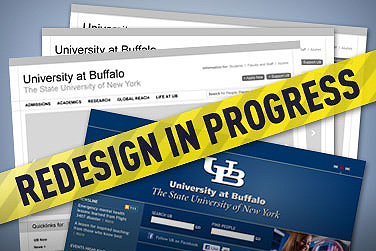News
UB redesigning home page

After viewing UB’s new home page, prospective students and other visitors will gain a sense of what life is really like at the university, both inside and outside the classroom.
In the digital age, a university’s home page often is the first place that prospective students and faculty go to size up the institution. What they see on the Web informs their perception of a school and what their life there might be like. Donors, neighbors and alumni looking to reconnect all turn to the Internet to gauge a university’s priorities.
Recognizing the importance of a strong and vibrant online presence, the Office of University Communications is leading the redesign of UB’s home page, with the goal of creating a site that reflects UB’s exciting culture and unique identity, while enabling people to find information quickly.
The redesign includes the overhaul of www.buffalo.edu, as well as the creation of new, top-level pages that introduce such important topics as academics, admissions, research, UB’s global reach and life at UB. The new suite of pages will transform UB’s public face on the Web, marrying rich, multimedia features to information architecture that helps users locate information easily.
The goal is to support recruitment and other key university objectives by showcasing the “UB experience,” spotlighting the institution’s people and work. Prospective students and other visitors will gain a sense of what life is really like at UB, inside and outside the classroom. Feature stories on the front page will build a sense of pride in the institution.
Members of the campus community can receive and comment on project news by visiting UB’s home page redesign blog, where the redesign team will be posting updates including “wireframes”—layouts that show details like the size of buttons and sections on a Web page.
The redesign began last year and the first new pages, including the revamped www.buffalo.edu, are scheduled to debut this June.
“I’m confident that our new approach will help UB tell our story more effectively,” says Joseph Brennan, associate vice president for university communications.
“We’ve taken the time to understand the needs and wants of our university stakeholders, and to carefully plan changes that will help achieve UB’s academic and administrative goals. We want our new home page and related top-level sites to help us attract the right mix of students and recruit the most promising new faculty members,” Brennan adds. “We also want our Web presence to help us deepen our relations with parents, alumni and friends of UB and make it easier for our students, faculty, staff and neighbors find the information they’re looking for.”
In a national survey of prospective students by higher education consulting firm Noel-Levitz, 88 percent of respondents said they would drop a school from their search or be disappointed with a school if that institution’s website did not have the content they needed. Nearly one quarter of respondents said they would drop a school from consideration if they had a bad experience on its website. For many students, looking at a college website is their primary way of collecting information about a school before they apply.
A cross-disciplinary team representing University Communications, Undergraduate Admissions, Student Affairs and Web Services is using feedback from partners across UB to drive decisions about the placement and tone of content on the home page. An advisory council for the project includes leaders from academic and services departments.
The look and feel of the new pages will be based on extensive research on user needs, including interviews with more than 300 students, staff, faculty, alumni, prospective students and community members.
Before planning the new pages, the redesign team also completed benchmarking, examining about 100 other university sites to investigate how other institutions approached branding, content and layout, and how those institutions used social and mobile media.
Members of the working group also spoke by phone with colleagues at Boston University, Duke University and the University of Texas-Austin to discuss what worked and what didn’t in recent home page redesigns at those schools.

Reader Comments